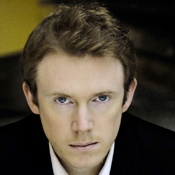Those attending the LA Phil concert at Disney Hall this past Saturday night to hear a couple of young, not exceptionally well-known musicians — conductor Daniel Harding and violinist Renaud Capuçon, 37 and 38 years old respectively — might not have had expectations as great as if the musicians had been, say, Gustavo Dudamel and Gil Shaham. But that would have changed by the end of the concert.
From the opening notes of the Violin Concerto by Erich Wolfgang Korngold in D Major, the key of many of the great violin concertos in the repertoire, to the closing D Major chord of the Symphony No. 5 by Gustav Mahler, the audience was treated to a wonderful evening of music-making. The Korngold is a perfect companion piece to the Mahler for a couple of reasons. For one, Korngold dedicated his violin concerto to Gustav Mahler’s wife, Alma, a composer in her own right, who is said to have influenced her husband’s compositions, including the Symphony No. 5. Secondly, the third and fifth movements of the Mahler (the Scherzo and Rondo finale) are in the same key as the Korngold (D major).
The Korngold is a large-scale concert showpiece for both violin and orchestra, and Capuçon was more than up for the task. His command of the instrument and the piece made him seem larger than life. From the outset, he, Harding and the LA Phil captivated the audience with the wonderful classical- and film-score-influenced concerto. Capuçon, who was last in town in June 2011 with his brother, cellist Gautier Capuçon (https://culturespotla.com/2011/06/music-review-dudamel-concludes-brahms-unbound/), conveyed the full range of the musical landscape of the Korngold with exquisite technique and style.
With the triumphant and highly acclaimed Dudamel Mahler cycle from last year still fresh in our memories, Daniel Harding chose to perform the fifth symphony (see https://culturespotla.com/2012/01/dudamel-and-the-simon-bolivar-symphony-orchestra-perform-mahler’s-fifth/ ). That might have seemed a risky choice for an LA audience still smitten with Dudamel’s performances.
Although Harding may have benefitted from an orchestra well rehearsed in Mahler, he brought an insight to the fifth befitting of someone who was recently named conductor laureate of the Mahler Chamber Orchestra. He produced a sound that was well balanced, not an easy thing to do with a piece so heavily laden with brass and percussion. At the same time, the brass solos were especially noteworthy, with outstanding performances by the principals (Andrew Bain, horn, Thomas Hooten, trumpet, and Nitzan Haroz, trombone). Harding showed us that Dudamel is not the only one who can produce a truly remarkable performance of this symphony, and reminded us that we cannot hear this piece performed live often enough.







